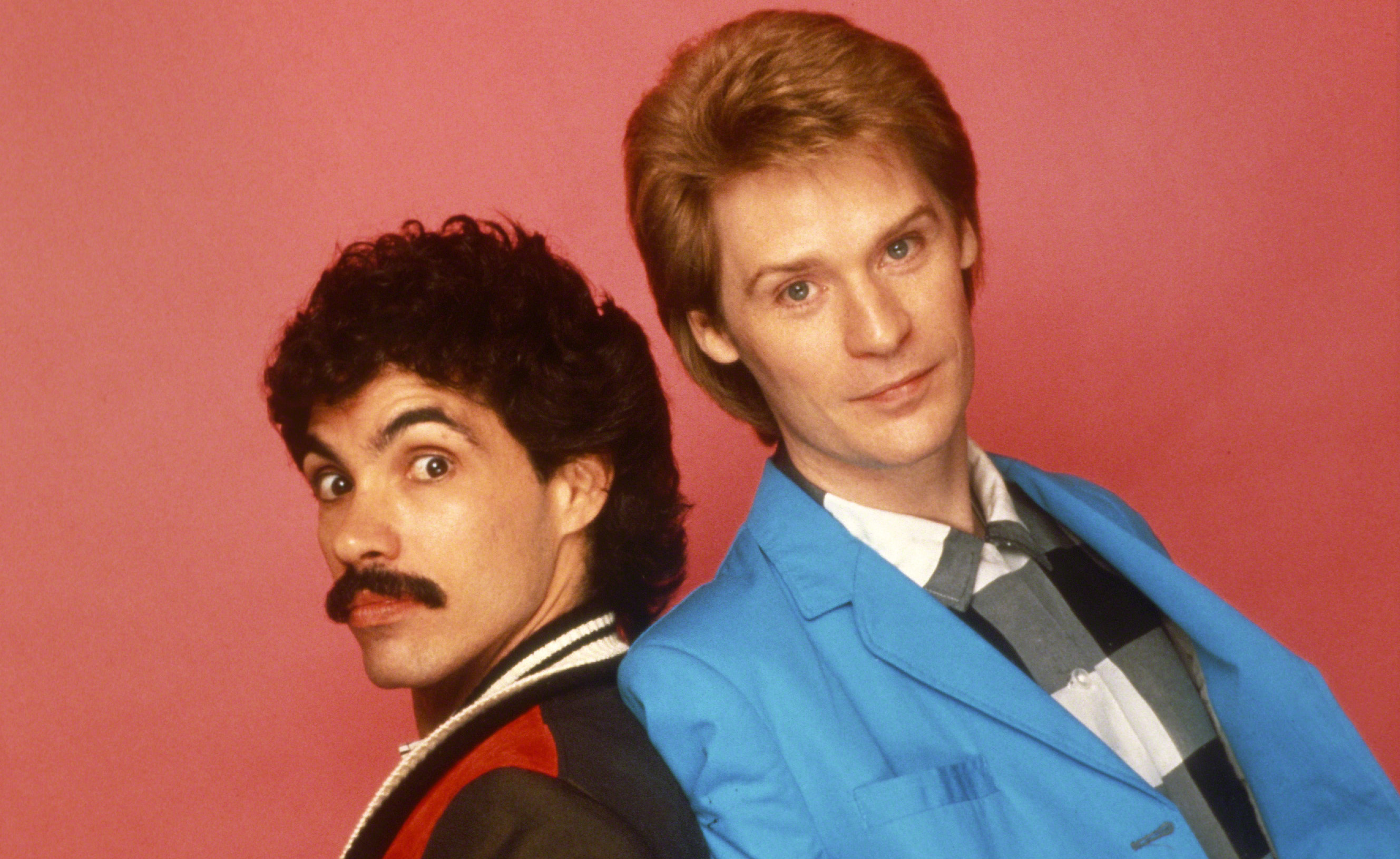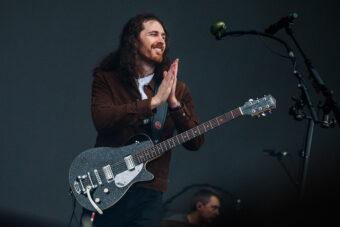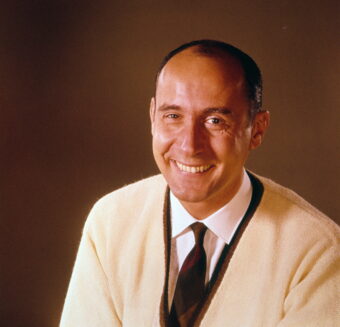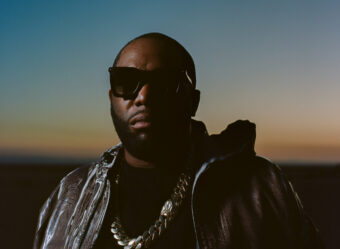This article originally appeared in the July 1988 Issue of SPIN.
“I am he, the light-bearer, Lucifer, the morning star!” shouts the handsome figure, attired in a black satin cloak, masked by mist, as he takes the stage.
The musicians gathered before him react with instrumental dismay, their pleasant tunes instantly turning sour and discordant. Stringed instruments now become tortured, their cries smothered by brutal drums. The bluish light within the chamber is swiftly fading, leaving only the candles flickering before the raised platform. On the fringes of the audience, braziers are lit and sickled-sweet smoke pours forth, enveloping the onlookers. It is high-grade opium, burning in ivory billows.
As the music crowd more abrasive, wailing and piercing, a number of sinister black-clad persons suddenly appear beside the ashen performers—from a trap door?—and they physically attack them with savage fury.
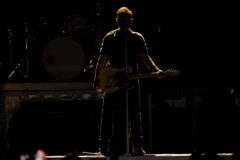
Also Read
SAME AS THE OLD BOSS
Rock singer Daryl Hall shifts in his exotic seat, a throne-like chair constructed from antlers, feeling utterly fascinated by the strange saga he’s reading. Through a nearby window, the late amber sun of May lingers, as if entangled in the treetops of rural Dutchess County, New York.
Margaret George’s historical novel, The Autobiography of Henry VIII—with Notes from His Fool, Will Somers, lies open to page 496 upon Daryl Hall’s crossed knees as he reads on in the twilight of his secluded farmhouse retreat. The bizarre scene, depicting an allegorical masque staged circa 1530 by Queen Anne Boleyn for her diversion-craving king, contains the kind of stark symbolism that Hall constantly seeks out, scrutinizes, and then somehow replicates in virtually everything he does.
The son of a foreman in a dye-casting factory and his bride, a former big band singer, Daryl Franklin Hohl (he legally changed his surname in 1972) grew up in rural Pennsylvania, a woods-wandering loner with Arthurian myth and the music of Ike and Tina Turner as his secret companions. Although he was a choirboy in a Cedarville Methodist church, Daryl’s adolescent sense of musical uplift derived less from the sacred than from the profane—in this instance, the suggestive R&B oozing out of Chicken Hill, the black ghetto of nearby Pottstown, PA.
Much later, in the mid-Seventies, after a measure of success drawn from the dualities of blue-eyed soul, Hall spent years studying the occult, sifting through Druidic scriptures and cryptic tracts by British magician Aleister Crowley. Turning inward, he weighted the merits of such doctrines as a means of prevailing through personal will, and sought out kindred spirits in the music of Peter Gabriel and Brian Eno.
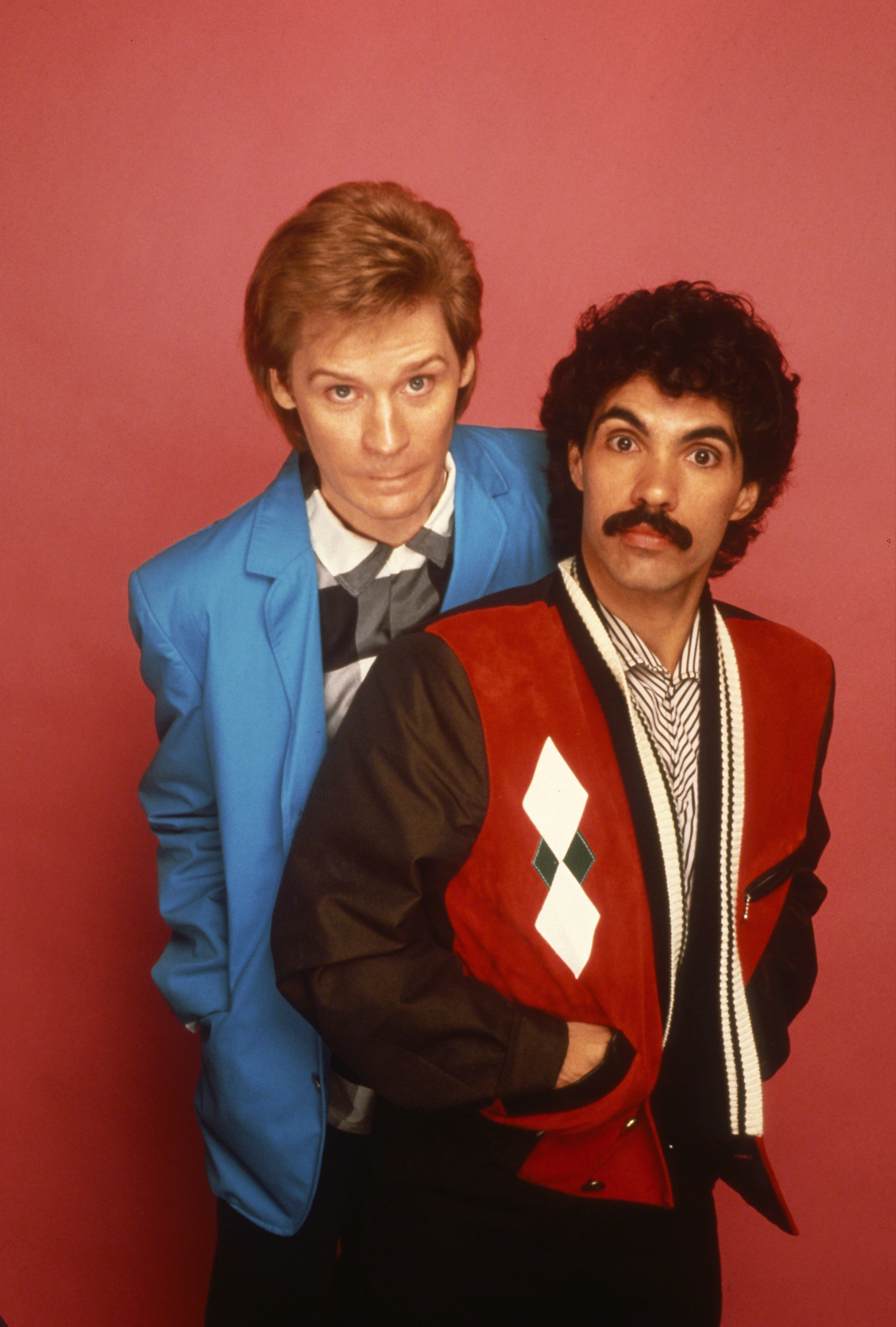
He’s long since discarded much of the murky data as claptrap, integrating “what remained undeniable” in a manner “too intimate to easily describe—except to say that what I got from it was a sense of my own ability to make things happen, to literally rely on my own soul for strength. Call them mental exercises.”
“I still read constantly,” he continues, “but now it’s mostly these thick works of historical fiction and mystical fantasy, plus great detective stories from the Fifties. I thrive on the stuff—it empties my head and charges me up at the same time, in order to do my own creative thinking. These days, I enjoy the mystery of things more than the solutions.”
The latest outcome from the matrix of his music, and the uncommon partnership that yields it, is Ooh Yeah!, and exquisite album some thought might never come to pass. Hall had put some distance between himself and longtime collaborator John Oates in a 1986 solo move. And although he always claimed it did not constitute a breakup of the most commercially popular duo in the history of rock ‘n’ roll, he wasn’t certain of the consequences of his actions, either.
“Doing my last solo album, Three Hearts in the Happy Ending Machine, made me realize the difference between a Daryl Hall LP and a Hall & Oates LP,” says Hall, 39, flicking his blond thatch from his Teutonic forehead with a flash of his thin fingers. “It comes down to our voices: separate, distinct, and explainable only through intuition. It’s a special thing, but we always have to be ready for it; you can’t force it. Meanwhile, the solo record came at a time when I had realized all my current ambitions in the duo, while personally feeling like I’d accomplished a complete cycle.”
“I’d always wanted to perform at the Apollo Theater in Harlem, to show how the hybrid music John and I had created from black Philly soul and white rock ‘n’ roll could cross over into both worlds, both spheres. And to do that in the company of Eddy Kendrick and David Ruffin of the Temptations [the concert was commemorated on a live 1985 LP], who I’d hung out and even informally sung with as a young guy—that represented a high point I’d always hoped for. Plus a new starting point I’d been excited about and unsure of.”
“See, I’ve never been able to see the new program until I’ve departed from the old one. For instance, John and I have been identified with Philly soul music for more than a decade, yet we haven’t lived or worked in Philadelphia for almost twenty years! I marvel at that, myself. Actually, our entire musical development has been rooted in Manhattan, either in Yorkville or Greenwich Village, which is a completely untold tale.”
“Lastly, there is a constant pattern of dualities, opposites, yins and yangs in my life and career. There’s not completeness without the tension of differences. And John is a fully fifty percent of the saga. We have a complex way of interacting musically, but our ways of looking at everything are in real contrast.”
“You can see it in so many things, like how we spent the time apart. Like, I needed to try my wings solo, put myself out there in a kind of blind jeopardy. He didn’t. Is it our differences that keep us together?” He scratches his mane in bemused laughter, as the night rushes in around him. “Or is it the similarities that we can’t see, ourselves?”
“It’s funny, but the most important thing for me during my three-year recording hiatus from Daryl was learning how to fly solo,” says John Oates, 38, draining a bottle of apricot juice in his cozy Greenwich Village apartment, as he leafs through a copy of the almost comically complicated Commercial Pilot’s License Program. “I’ve been flying alone for three years now—it took two years to get my license, training in a Piper Dakota plane, and then another year to get my instruments rating.”
“An instruments rating means the ability to fly blind,” he begins with a serene smile, tapping lightly on the textbook. “It means that you have the capability to fly out at night, in rainy weather, cloud cover and fog, without benefit of any visuals beyond the data on your instrument panel.”
“I got into all this stuff during the 1984-85 Big Bam Boom tour, our last major roadtrip together for a Hall & Oates record. We did most of the traveling in a private plane, and I got accustomed to sitting in the jumpseat with out pilot, Jay Sligh. He gave me a manual to read, I got hooked, and he offered to take me through the entire process of training. Eventually, I soloed after ten hours of flight time—this was in the spring of ’85, one a beautiful windless day out of Long Island’s Brookhaven Airport.”
“I’ve since taken my wife, my dog, and various friends on dozens of day hops to Martha’s Vineyard or Vermont. And as I was producing and writing during that period with Parachute Club and Ice-house [Oates co-wrote the latter band’s Top Ten single, “Electric Blue”], I’d make my own business flights to Canada or wherever.”
A bright, quick-witted conversationalist, John Oates is a native New Yorker who grew up in the Pennsylvania countryside. He was five when his Italian mother and British-Moorish dada reluctantly uprooted the family from their Sicilian neighborhood in the East 20s to allow Al Oates to follow his job in a machinery plant to a site relocation near North Wales, Pennsylvania.
“But my parents stayed so homesick for the city that they took my sister and me back to Manhattan every single weekend, where we’d camp out in my grandparents’ apartment. It was comforting and permanently disorienting.”
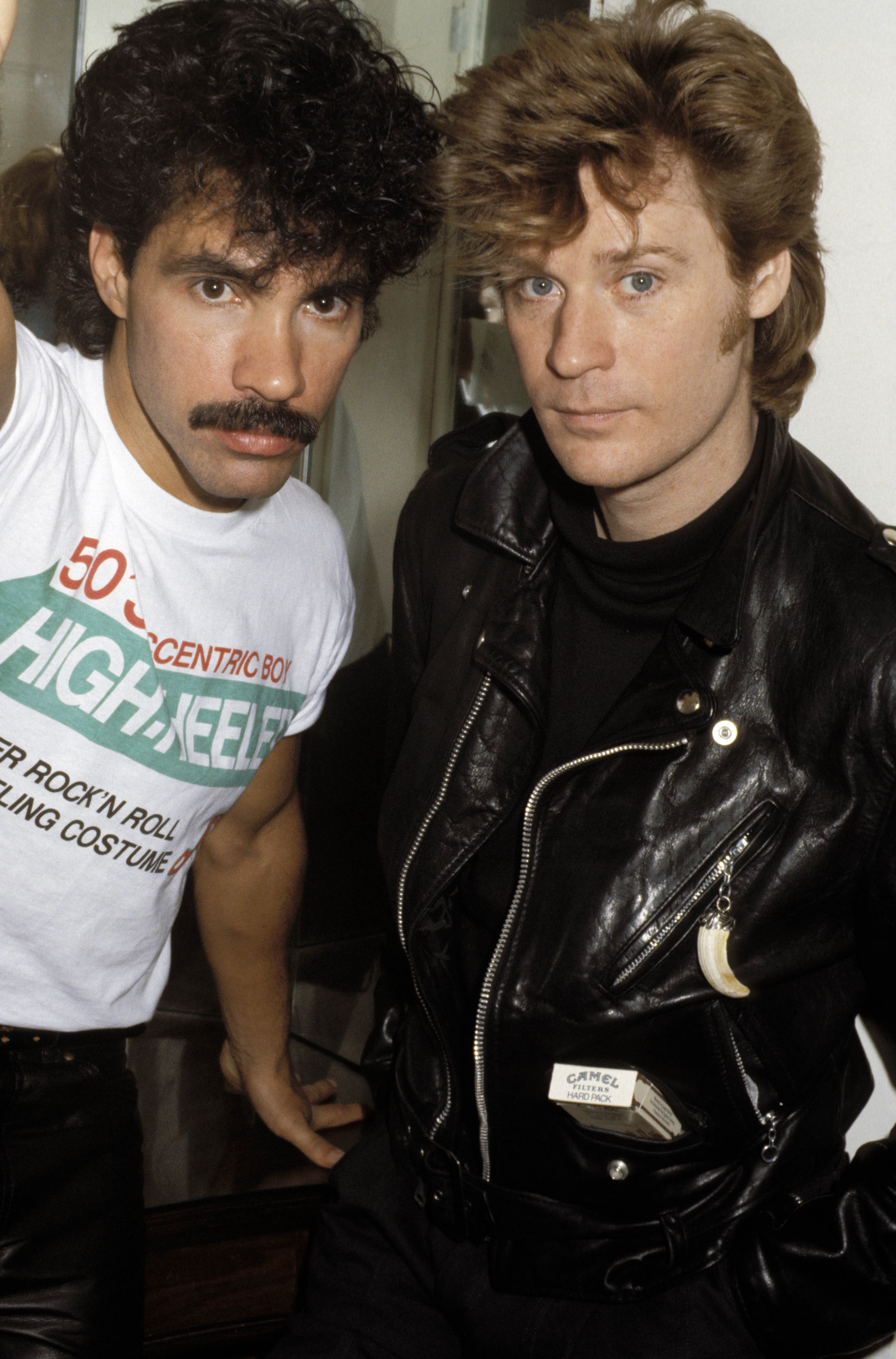
The swarthy, smooth-featured John is still muscular from his days as a championship wrestler at North Penn High School and Temple University. But the most strongly enduring characteristics form his unsettled boyhood are his hunger for the adrenaline of playing live rock ‘n’ roll—first implanted in him at a 1955 Bill Haley concert at Willow Grove Amusement Park outside of Philly—and his fear of falling into a drab, dead-end occupation.
What led to a dicey hobby like flying? The independence? The freedom from earth-bound career concerns?
“Well, I’m not a big career worrier, and I like the challenge of independent activity,” he says, “but I’ve found that the best part of flying goes deeper than normal exhilaration. I was recently flying back to New York alone from New Hampshire, and the sky was clear and quiet, with no moon and only a few airlines chattering over the radio. It was about 11:00 PM when I crossed over Hartford, with the dim light of Danbury in the distance below. Straight ahead it was pitch black, with a panorama of stars over my head.
“And the sensation it gave me, it was a peaceful alertness. Just the sense of ease you have when technical confidence and a beautiful simplicity come together. Which—I could add—isn’t such a bad description of me and Daryl when we’re getting it right musically. Because it’s very moving when you can forget yourself in those kinds of movements; you take everything in and almost disappear at the same time. If you think about it, it’s nice to be proud of things that provide release, eh?”
For all the hundreds of thousands of times Daryl Hall and John Oates have harmonized together, bending their peculiar vocal strengths into a blend greater than the sum of its parts, it’s entirely possible that they’ve never really listened to each other terribly closely. The ironic similarities and quirky complements are just subtle enough to escape overt on-the-job detection by either man. And their time apart boasts the same blissful inattention to parallels.
Since 1976, when they relinquished their shared flat on East 82nd Street, they’ve had the same Village pads within a five-minute stroll of each other, but that proximity appears to be as unconscious to them as the fact that they’ve both acquired country homes in the interim.
Observing them this past March at the Hit Factory studios on West 54th Street during the making of Ooh Yeah!, one could say that they combine the best aspects of the dedicated daydreamer and the can-do determinist, magically shifting roles as circumstances demand. The tracking of “Keep On Pushin’ Love,” a lean, atmospheric slice of rock ‘n’ soul verve, makes for an excellent case in point.
During the early composing stage, the song possesses a lot of specific-but-spacy guitar from Oates, most of it brisk picking offset by blended rhythm figures. John is a quick and dexterous player, but these fluid skips between melody and groove are the legacy of years of bandleader chores on the Philly soul scene—wherein vocals and instrumentation constantly trade narrative prominence.
Once the guitar finds its proper support-and-spotlight pattern, Oates begins adding a casual bopping vocal that boasts the pre-rap pacing of some bygone Muhammad Ali haiku.
“That sounds like a goddamn Curtis Mayfield spoof!” quips Hall, cracking up Oates in mid-tempo as the guitar/vocal dialogue oozes onward. T-Bone Work, the bearded “Saturday Night Live” bassist who has been an arranger-troubleshooter for Hall & Oates since 1982, joins in, plunking out a verse structure for Oates’s improvisations. Next, Oates puts two hours into a set of lyric stanzas, and by the time Hall begins to layer falsetto filigrees into the experiment, Daryl’s also trading fire with Oates’s guitar. “Curtis Mayfield meets Jimi Hendrix!” John hollers giddily as they gather steam, and he almost means it.
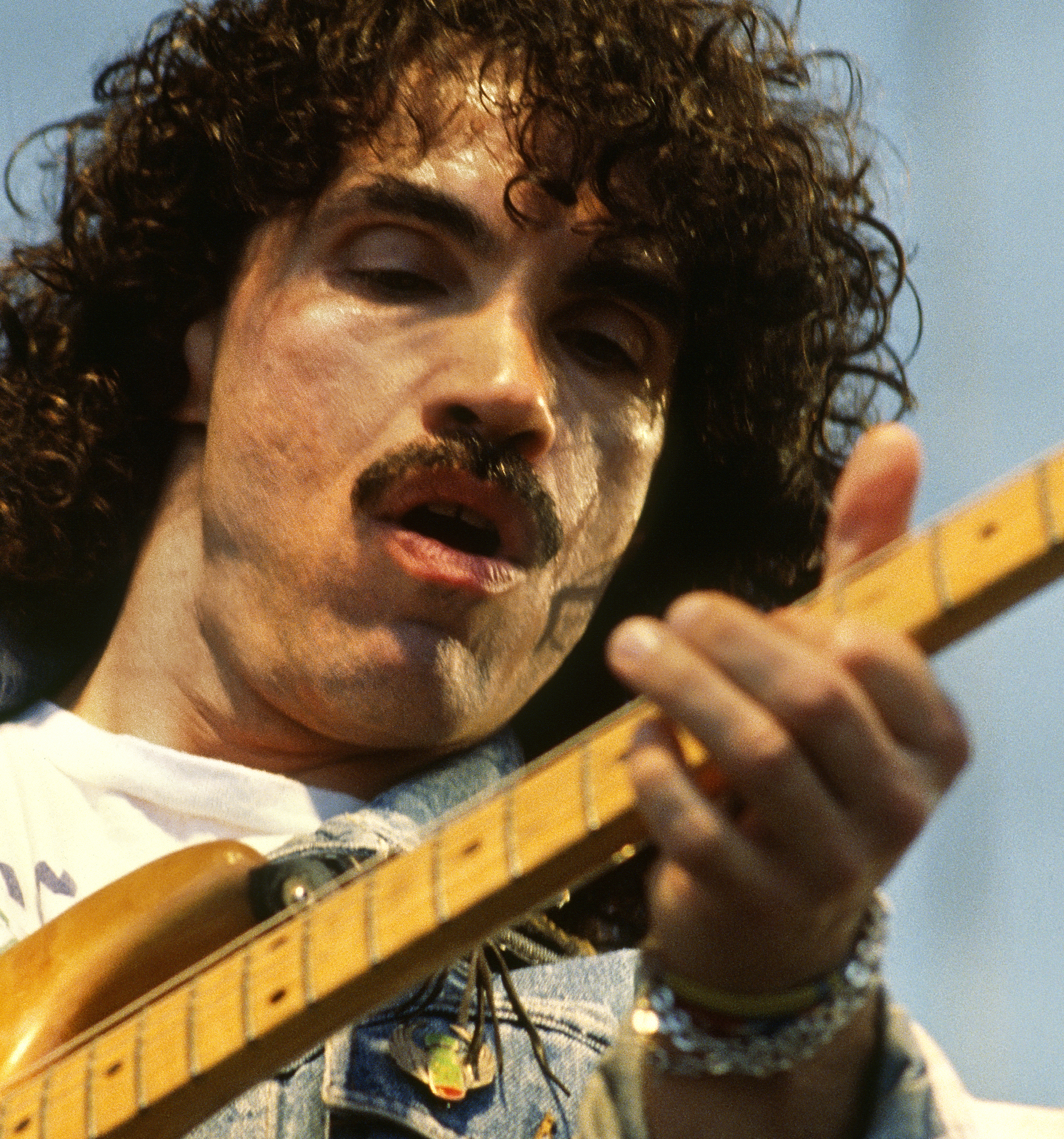
In the weeks that follow, Hall and Oates sit at opposite corners of the mixing board and play Juke Box Jury as the raw track of “Keep On Pushin’ Love” is periodically replayed. As they listen they think out loud, sometimes finishing each other’s sentences, but never getting the least bit snared in each other’s thoughtwaves.
“Let’s get some sax in on this,” Hall decides one afternoon, sending former Billy Joel hornman Mark Rivera before the studio boom mike to concoct a part.
“…And it shouldn’t be a riff thing so much as a counter-melody,” Oates urges.
“…So we’re looking for a floating quality,” Hall coaxes, “a sequence that spirals…”
“…And then sneaks back into the last chorus,” Oates concludes.
Rivera gets the desired effect on the ninth or tenth pass, with no further discussion on anybody’s part, and then it’s on to the next objective. Throughout, Hall and Oates continue a friendly little sub conversation about various trivia, and then spin off into separate zones of responsibility until another impromptu consensus is required several hours down the line.
Over the course of days, the instinctively deferential modus operandi becomes clear: For all their nonchalant stares and confiding glances, they never, ever watch each other. The pair has a trust based on shared self-reliance, and it is that odd that creative contract that has probably kept their tensile bond from becoming a booby trap.
All the great singing duos in the rock ‘n’ roll pantheon have traditionally forged compact streaks of brilliance intercut with a looking-glass brand of bickering. Sam and Dave, for all their whooping Chilin Circuit camaraderie, never cared for each other once the last funky rim-shot rang out—largely because the one always seemed to remind the other of his unspoken doubts and solitary fears. Simon and Garfunkel seldom strayed too far from smoldering mutual disesteem—and the doomed chemistry was plain in every performance they gave: From temperament and physical stature to vocal quirks, they constantly remind each other of their most plebeian limitations. And the you have the Everly Brothers, two guys whose talents remain so indecipherably entwined that they transform sibling rivalry into reciprocal rage.
“But the extra rope I guess we give each other is not the main reason anything we do is worth a shit,” John Oates cautions one evening over a spicy Chinese dinner. “Instead, I suspect we’re tied to a long tradition that doesn’t really exist anymore.”
“Well, it exists,” Hall demurs, “’cause we’re here, but let’s just say we’re the current stewards. I don’t think that we’re the last or the oldest to perform and make records the way we do. I believe we’re part of a time-honored school of American songwriting and recording that’s actually becoming more popular again—even if a lot of British acts are lately selling the essential embodiment of the sound back to us. Somebody was saying to me earlier that the only way to have a hit at this point in time is to have an urban-oriented record, with the racial and cultural integration that implies.”
“We feel a happy and proud part of that, and it began for us with an album called Abandoned Luncheonette. We got a lot of mileage from that LP, with people as flattering as Led Zeppelin picking it as a favorite and taking tapes of it from motel to motel.”
At the time, Hall & Oates were recent immigrants to New York City, tossing their belongings into their two-bedroom billet at 433 East 82nd Street and commencing non-stop touring in a 1968 GTO John had appropriated from his father. Daryl had broken up with his wife Bryna Lublin and met Capital Air stewardess Sara “Sandy” Allen, devising two songs—”She’s Gone” and “Las Vegas Turnaround” in the process. The constants in this time of upheaval were the fragile sense of heritage both young men carried in their heads.
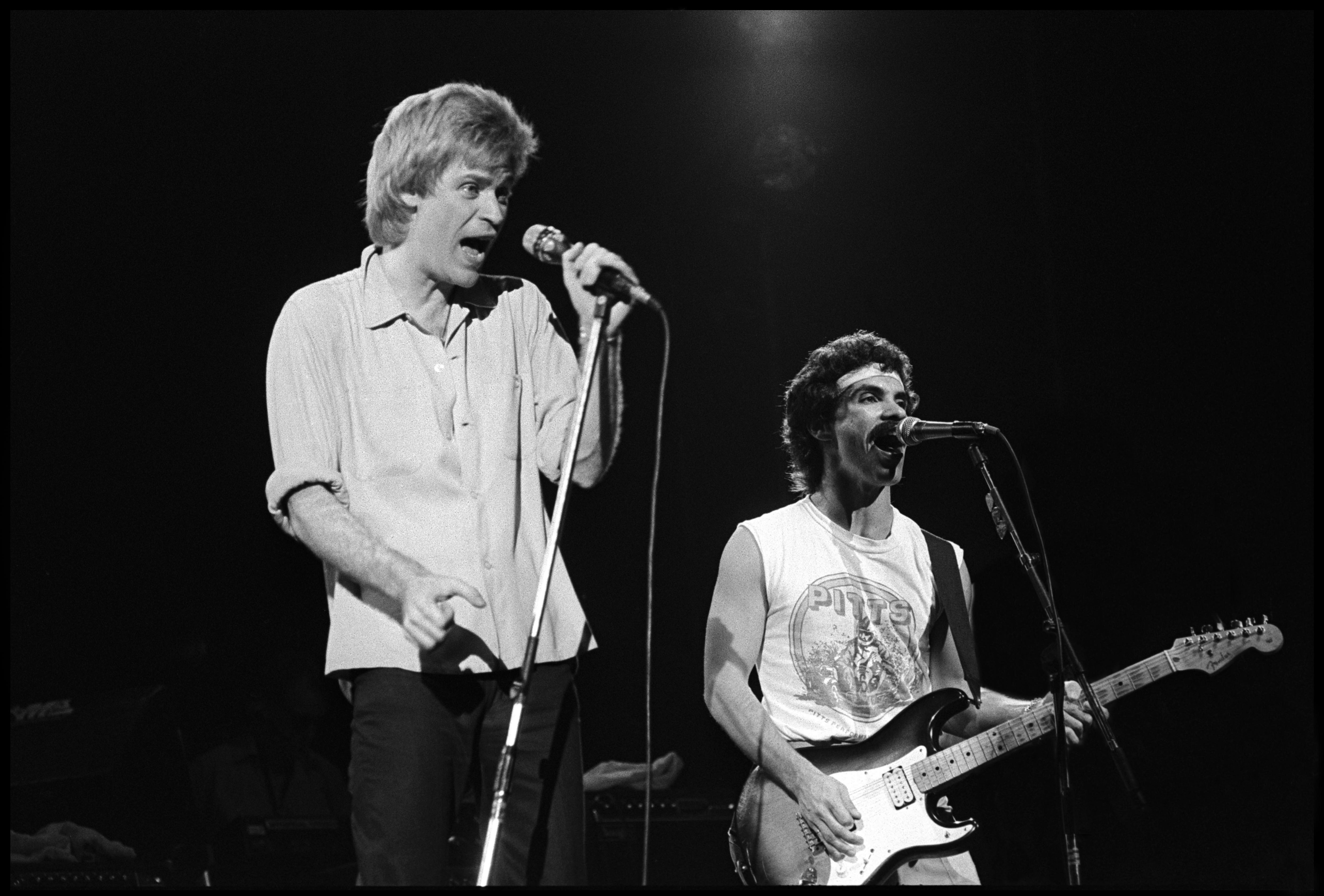
“For us, Philly was like a farm club that nurtured a way of making rock ‘n’ soul, hammering the skills and the drive into you,” says Hall. “Everything you did seemed to have a pop tune to coincide with it. The first time I ever kissed a girl I was ten years old, and I remember the kiss as well as I recall the song blasting out of the car radio, ‘Wake Up Little Susie.'”
“The fact of the fully integrated Philly school system and the network of radio-station-sponsored dances combined to make you super-conscious of black and white youth culture crossing over into each other. And it was a big ambition to get into the studio audience of “American Bandstand,” so if you couldn’t dance good enough to show off on TV, you were a wimp. The crucial factor was that you were allowed to be professional really early. I was still in my teens when I got my first recording contract with the Temptones, my vocal group. It happened by winning a talent contest at the Uptown Theater—the same venue where the Jackson Five and the Temptations cut their teeth.”
The Temptones cut two sides for Arctic Records, the local label that had scored a string of hits wit sepia songbird Barbara “Yes I’m ready” Mason. Nothing happened overnight for the ballsy white R&B crooners, who did an endless stretch of NAACP benefits and lip-synch record hops, but the Arctic deal introduced Daryl to the Philadelphia studio community. He began writing songs with Lenny Huff, cutting singles with Kenny Gambel and the Romeos, and then became part of the Gamble and Huff session staff when the two men turned Sigma Sound Studios into one of the nation’s foremost soul shops. Hall continued to write with Chubby Checker and Len “1-2-3” Barry while adding keyboards and support vocals to records by the Stylistics, and Clyde McPhatter.
At the same juncture, John Oates was heading the Masters, another top band that recorded for the Record Museum, home of the Soul Survivors (of “Expressway to Your Heart” fame). When the draft dismantled theMasters in 1968, John became the Temptones guitarist, his first date with the act being an uneventful showcase stint at the Village Gate that led to the group’s own demise.
“What attracted me to Daryl,” John muses, “was the appreciation he also had for an historical perspective on music. We came along in a transition stage between the old-fashioned music business of Tin Pan Alley and the Big Band framework, and the new music business—which was Brill Building pop, doo-wop, combo rock, and the democratic/hippie idea that you become a music force by functioning at your own level of expertise. But there was a strong work ethic going on.
Daryl filled his own days by student teaching at Stoddart-Fleisher Junior High—”I was a music instructor; it was a ploy to stay out of the Army. I’d play bar and club gigs until two or three in the morning and then stumble into the classroom at 8:30 AM.” He explodes in laughter. “All I really wanted to do was hip these kids to Sly Stone and show them the cover of John Lennon‘s Two Virgins album!”
A fresh source of paychecks surfaced in the form of song publishing, Hall & Oates parlaying several cheesy deals struck at the Schubert Building on South Broad Street into a $130-a-week retainer with the post-Brill Building stables of Chappell Music. Tommy Mottola, Hall & Oates’s longtime manager (and now the president of CBS Records) was the 21-year-old head of Chappell’s contemporary music division when he signed the duo.
“We’d go up to New York once a week or so to audition our latest material on acoustic guitar and some broken piano in Chappell’s Seventh Avenue offices,” Oates remembers. “Our stuff was folk-rock with an R&B undercurrent—or so we thought. But it didn’t matter, because the whole thing was flexible, because it was just you or your instruments in a bare office. What didn’t gel, you just revised on the spot. There were no painstaking demos with two-hundred-dollar-an-hour Synclavier laid under them. If nobody liked your shit, you all went out for fresh packs of cigarets and began again. If you went broke, as we often did, you took jingles sessions, and we did ones for Ladybug clothes and Lawn Doctor.
“What’s unfortunate in today’s music world is that a new group doesn’t get a chance to make mistakes. When Tommy got us signed to Atlantic Records in 1971, we did a dump album like Whole Oates, a smart one with Abandoned Luncheonette, and a fucking weird hard rock one with War Babies, the last of which got us dropped in favor of the Average White Band. They might have been a better groove outfit, but they couldn’t write songs as prolifically as us, and so what? Everybody always had the option of starting over again.”
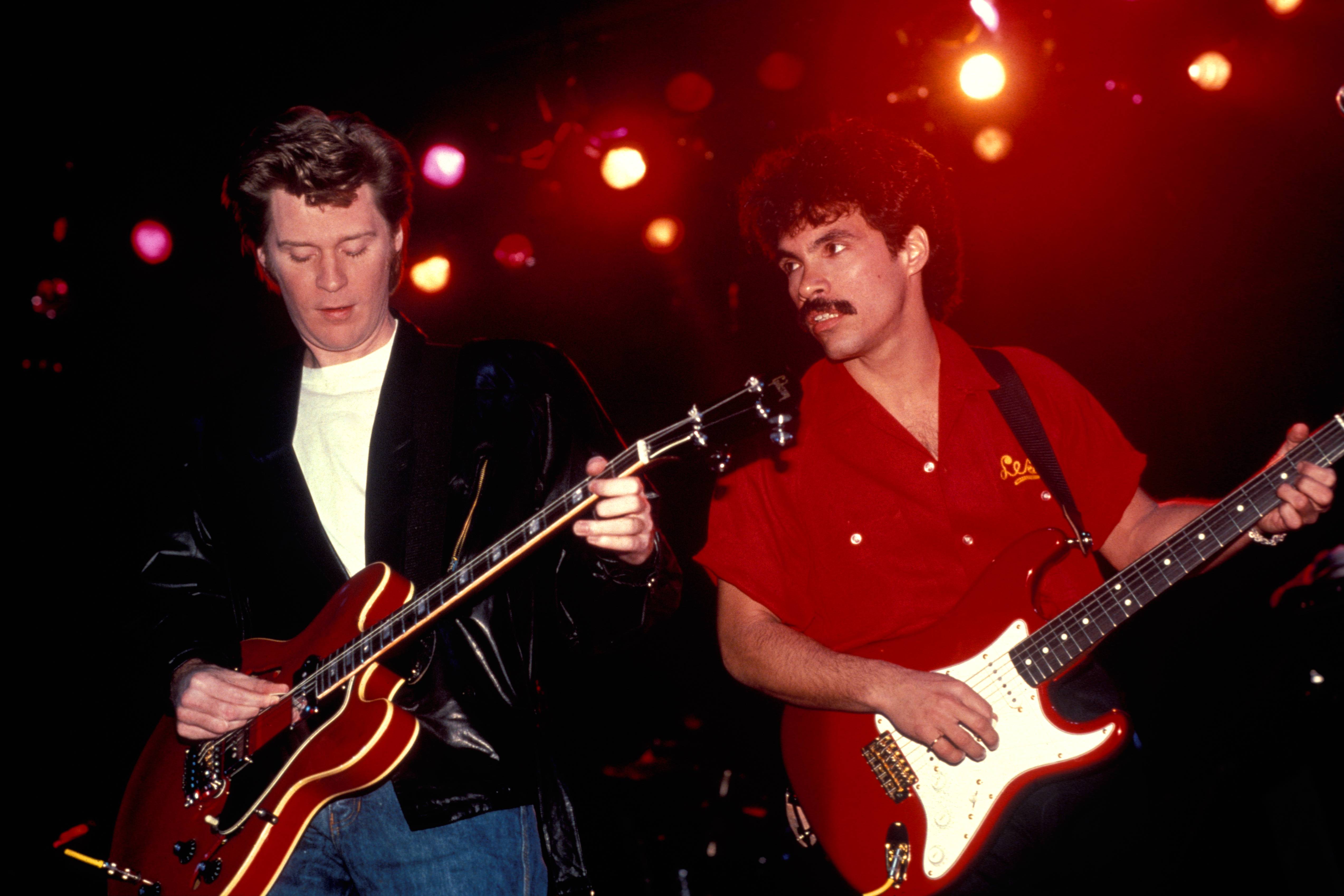
It was this luxury of commercial reprieve, coupled with a desire to persevere within a certain genre of pop song craft, that permitted Hall & Oates to sculpt a durable sound. Not that they always had a firm grip on their agenda.
“The Seventies were a mixed-up time, and we were no exception,” says Oates. “Part of it might have been the hodgepodge Yorkville neighborhood we lived in, because environment is a big part of the music you write and the crowd you identify with. This uptown corner of Manhattan was a mix of young businessmen, airline stewardesses…”
“…And,” Hall interjects, “let’s not forget all the old German war veterans singing Nazi songs in these zither-music cafés!”
“Our main hangouts in the area were Kenny’s Castaways, then located in the East 80s, and a rock ‘n’ roll saloon next to the old Ruppert Brewery called Home. John Lennon used to drink there with the guys from Elephant’s Memory. Other regulars were Peppy Castro from the Blues Magoos, Billy and Bobby Alessi, and a girl I dated named Shelley Plimpton—all of whom starred in the Broadway cast of Hair. Peppy and the Alessi twins also had the influential New York band Barnaby Bye, and then the brothers went out on their own, but mainly the whole crowd were songwriters for people like Peter Frampton, Richie Havens.”
Gradually the circle expanded to embrace Philly orphan Todd Rundgren and the clutch of crack session musicians he favored. As gentrification seeped into the East 80s, everyone either moved down to the Village, tagged along with Rundgren to Woodstock, New York, or became a rounder on a ragged orbit that included Bearsville Studios upstate, Max’s Kansas City and the Bitter End in the city, and the Mercer Arts Center—”which was better known as the Mercer Quaaludes Center,” says Daryl Hall.
“This was 1972-73, the heyday of the New York Dolls, and the Arts Center was a lovable concert dive off the lobby of the Broadway Central Hotel, a welfare fleabag in the East Village. If we weren’t wasted over at Max’s—or onstage, because we double-billed there with Springsteen and a lot of other people—we were getting into mischief at the Mercer Arts.”
Indeed, the Mercer Arts scene was a debauched tableau that would’ve made Henry VIII blush, teeming with cokehead cross-dressers and tatted-up rock poseurs of every stripe.
“I used to wear skin-tight satin pants,” says Oates, “and these halter top shirts with little puff sleeves. On top of that I put a white dog fur coat, and I finished off the ensemble with red, white, and blue platform sandals with four-inch soles.”
“Man,” moans the piggish singer, flushed with conflicting emotions, “the worst thing that ever happened to me was when platforms went out of style.”
At the end of the night, or the first light of dawn, everybody teetered over to the tiny Pink Teacup on Bleecker Street for a soul food breakfast.
“And then I’d go home to my cheery apartment,” Oates deadpans, “with the windows blacked out with crayon and tinfoil. Sunlight wasn’t high on my list of priorities in those days. We needed to tour to earn some money, so we took an opening slot on a lineup with Cheech and Chong, and Dan Hicks and his Hot Licks, during a swing through Florida.”
“Oooh,” Hall sighs, stirred by the reminiscence, “that was the trip where Hicks’s people had a sex game they used to play backstage, sorta like Monopoly. It was a board game except it had to do with wife-swapping and exotic drugs.”
“So now we needed a vacation,” says Oates, “because Daryl had wrecked our GTO by accidentally ramming it under the rear end of some hooker’s car one night on Park Avenue. So we chose wisely, and got out of town by joining a thirty-city marathon with Lou Reed, who was at his all-time Rock and Roll Animal freakiest! I’ve got Super-8 movies of him being shoved on stage in full stagger, while the rest of the band was punching each other out.”
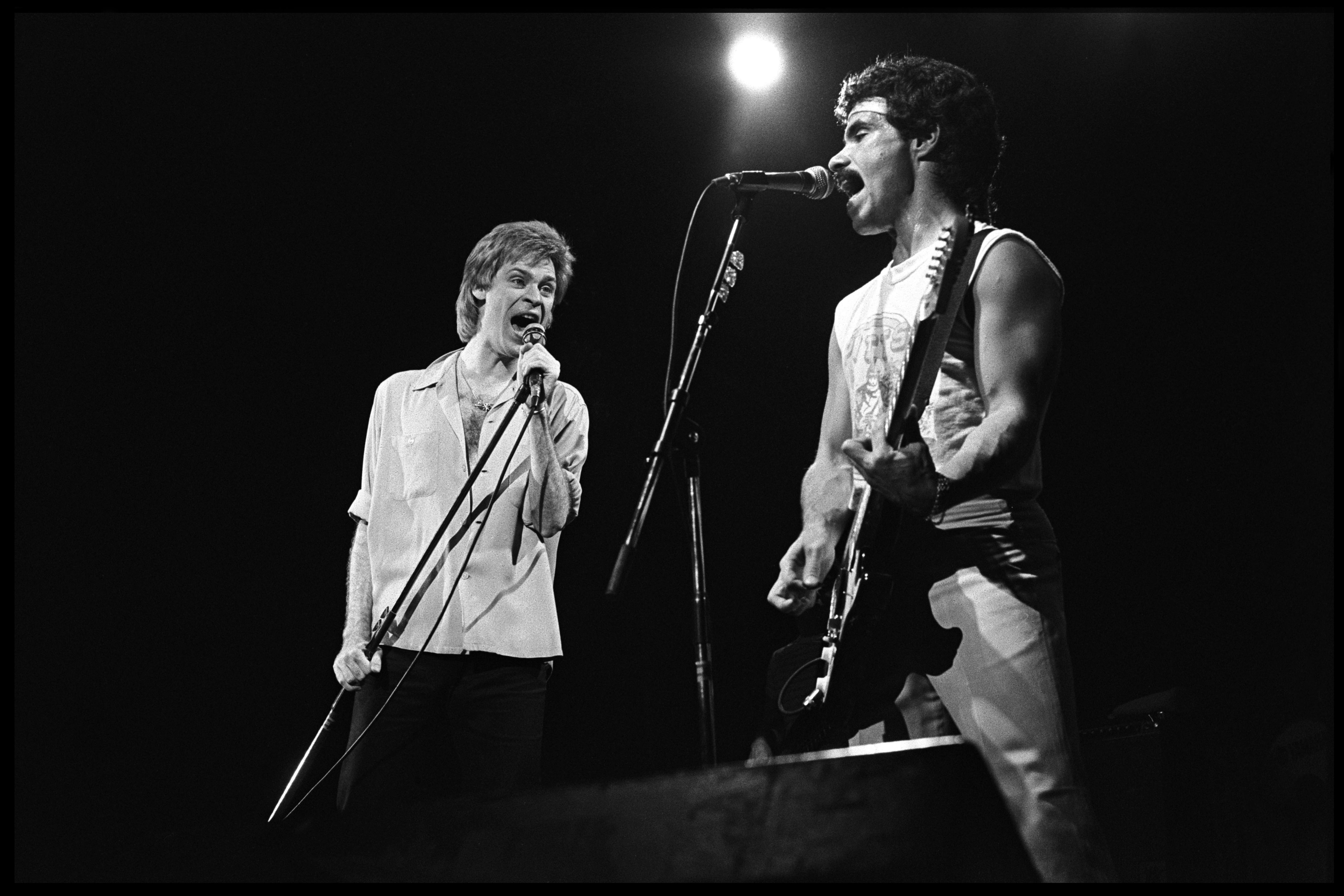
Hall & Oates returned to New York City just in time for the collapse of the facade of the Broadway Central Hotel, which resulted in the building being condemned and the Mercer Arts Center shuttered. The pair fled to Los Angeles in 1975, where they redoubled their efforts at songwriting and became genuine radio stars on the merits of smash singles like “Sara Smile.”
After a world tour, they returned to LA to rent the home of Playboy centerfold Stella Stevens—best known for her role as Appassionata von Climax in the film Li’l Abner. The superb Bigger than the Both of Us LP and the Number One single, “Rich Girl,” resulted from these labors. Soon afterward, however, the team tumbled into a commercial cut de sac when any and all beat-based music was dismissed during the Disco Sucks backlash. They languished on the rock-pop sidelines for nearly four years worth of hitless albums—although Along the Red Ledge (1978) and X-Static (1979) garnered their greatest critical raves up to that point.
It wasn’t until they began producing themselves for 1980’s Voices that a reversal of Hall & Oates’s fortunes arrived.
“It sounds trite,” says Hall, “but after all this stadium rock and Spinal Tap production sludge we realized we had to get back to our roots. The stuff that turned us on as teenagers was what we wanted to do anyway, so we retooled our entire performance and writing approach to reflect the intimacy of our singing. Our vocal mesh became the star again, and our songs became the show.”
Voices generated a slew of hits—”How Does It Feel to Be Back,” “Kiss on My List.” “You’ve Lost That Loving Feeling,” “You Make My Dreams”—but Hall & Oates knew they were in the right place before the LP ever reached the stores.
“I remember walking down West Fourth Street after this pre-release Voices listening party we’d held for friends,” says Oates, “and suddenly I was in tears, sobbing uncontrollably. I’d never felt that much emotion and inner gratitude for anything I’d ever done in music before. It really burst my heart.”
Since that time, Hall & Oates have never lacked for airplay on Top Ten sales. Critical acclaim, though has been slower coming. While Anglo soul acts like Boy George, Simply Red, the Pet Shop Boys, Johnny Hates Jazz, and Wet Wet Wet have all mined aspects of Hall & Oates’s innovative rock ‘n’ soul esthetic, none can match the men themselves for R&B song craft with an adroit rock vigor. George Michael may have recently been anointed as the fairest new face in blue-eyed soul, but the gap between his body of work and that of Hall & Oates is like the difference between Elton John and Irving Berlin.
“Sometimes a classic form like a pop song is so deceptively simple that the beauty is tough to see,” says Oates. “A lot of people have done Dylanesque wordplay in the last decade to get attention. Clever couplets are another shortcut onto the pop charts. But try to condense an honest emotion into a single within the restrictions of meter, rhyme, meaning, and the sound of the syllables themselves. And then attempt to put a band sound behind it to power it home with clarity as well as impact.”
“It’s not an easy sound to toss out,” Hall instructs, “because it must always have the vitality of a live performance or it falls flat. In a way, the songs trace the sound of American cities as they’ve evolved in our era.”
After this unaccustomed concord, Daryl Hall and John Oates both excuse themselves to catch separate taxis back to their respective hearths. Several weeks onward, as the rejuvenated duo prepares to strike out on a year-long global concert trek, they are characteristically balancing their music with other, more offbeat interests.
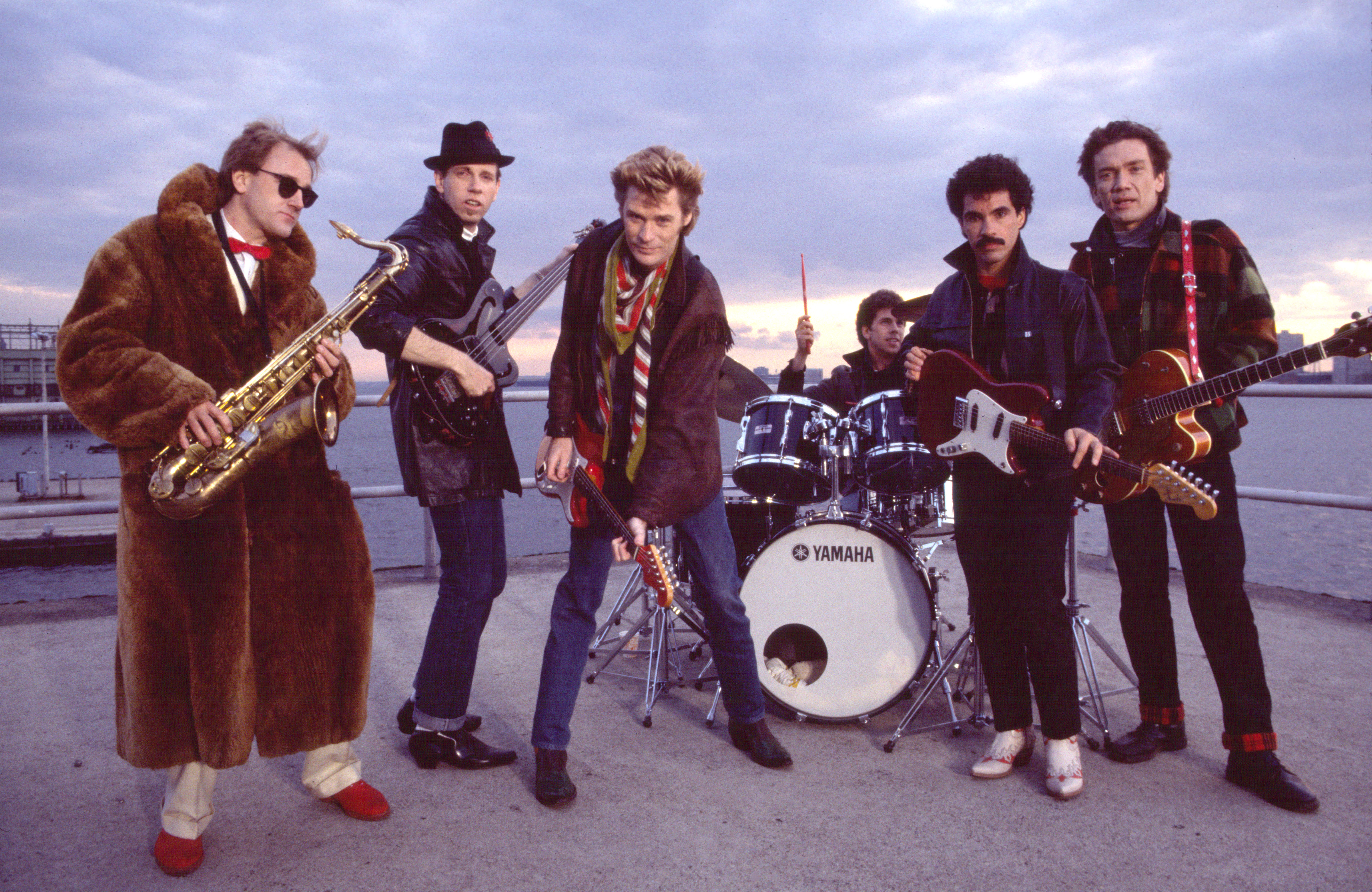
“I’m pretty concerned about local politics up in Dutchess County,” Hall confesses one afternoon after band practice at SIR rehearsal studios on West 25th Street. “They’re gonna ruin that corner of the state with sleazy re-zoning practices and slick development, the same way they spoiled Cedarville and so much of Berks and Montgomery counties in Pennsylvania. My girlfriend Sara and I have been spending a lot of our time at town meetings about these issues.”
What about sober, reliable John Oates? Is he relieved that Daryl and he have triumphantly reunited around the acclaimed Ooh Yeah!?
“Sure, but I’ve also been thinking how pleased I am that I gave up professional auto racing. During the making of many of our albums in the Eighties, I used to take off weekends to drive in races at Daytona and other big tracks. My last big race was around the time of Big Bam Boom, when I was driving a Pontiac Fiero in a 500-mile endurance test in Elkhart Lake, Wisconsin. I was in third place when the transmission seized going into a turn. The rear wheels locked, and the car plunged into an embankment. I woke up in the ambulance with my helmet split open, feeling pretty upset with myself.”
Because it was a close call, eh?
“Oh, no. Because I knew I wasn’t giving this high-stakes racing the level of attention it deserved! I’ve decided to go on the racing circuit this year—Monte Carlo, Indy, and the rest—but probably solely as a spectator. I mean, you can’t do everything. Between band rehearsals and my flight schedules, I barely have a spare moment to finish this great book I’ve been immersed in.”
Another pilot’s manual?
“Huh? No, it’s called The Gnostic Gospels. It’s based on the Dead Sea Scrolls and all these supressed mystical doctrines of an early Christian sect sympathetic to Egyptian hermetic teachings. The material is riveting. I mean, you don’t know what you’re missing!”

